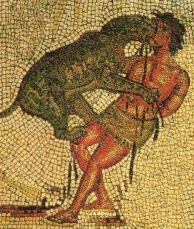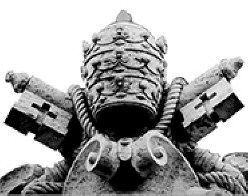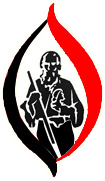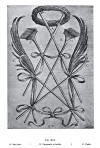|
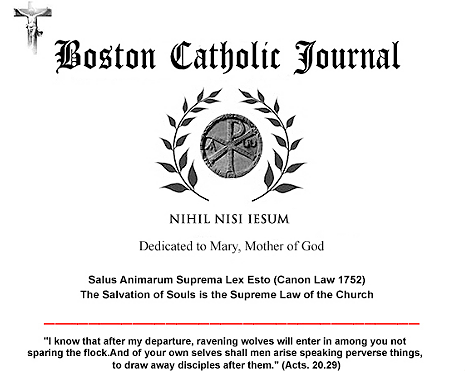
The Tortures and Torments
of the Christian Martyrs
from
De SS. Martyrum
Cruciatibus
(a Modern Edition)
Chapter V
Of Instruments the Heathen used
to Tear the Flesh of Christ's Faithful Servants, to wit, Iron Claws,
Hooks, and Currycombs
Three
separate and quite distinct instruments
were employed by the devil-worshippers (as we find in many Acts of
the Martyrs) for mangling Christians, namely, iron claws,
hooks, and currycombs. Of these the first sort
are mentioned in many places by Tertullian, particularly in his work
Against the Gnostics, where he writes:
“Some Christians they
proved by fire, others by the sword, others by wild beasts; yet
others tasted martyrdom from cudgels and iron claws.”
And in his Apology
to the Heathen:
“You set Christians
on crosses and fix them to stakes. Tell me, what deformed likeness
will not the clay assume, when set up on cross and stake? On the
gallows-tree is the body of your God first dedicated; and with claws
you scarify the sides of Christian martyrs.”
And again elsewhere,
“Yes! Let claws pierce
their flesh and crosses hang their bodies on high.”
So too St. Cyprian in
the Epistle to Donatus says:
“Spear and sword
and executioner are ready, and the claw that pricks and pierces,”
and in another place, “Now would the wooden horse rack them and
the iron claw pierce.”
Also St. Gregory of Nyssen,
in his Life of St. Gregory Thaumaturgus describes that:
“The posts were set
up whereon the bodies of those who remained firm were stretched,
and lacerated with horrible claws.”
St. Augustine, in his
Letters ,equally makes reference to them:
“When he has the open
confession of such enormous crimes — and this by no racking of the
horse or ploughing of the iron claws...”
St. Jerome, in his
Epistle to the Innocents also testifies that:
“When the bloodstained
claw was mangling the livid flesh, and pain was seeking to tear
the truth from furrowed sides;” and the same Author a little further
on, “Either side doth the executioner plough and furrow,” that is
with the iron claws.
And
Prudentius in his Hymn
of St. Romanus speaks of:
Costas bisulcis
execandas ungulus
(“Sides that must be cut open with the cloven claws”)
and further on:
Quam si cruenta membra carpant ungulae,
(“And if the claws rend your bleeding limbs ...”);
and still elsewhere:
Ille’ virgas, secures, et bisulcas ungulas ...
Tormenta, carcer, ungulae,
(“Rods, axes, and cloven claws ... racks, prison, iron claws.”)
Now these
claws — which can be verified by one preserved to this day
in the Church of St. Peter in the Vatican among the relics of the Saints,
and which we ourselves have seen, kissed, and venerated — were a sort
of iron pincers made as follows:
First, two longer pieces of iron were fastened together, much in the
same way as those forming a smith's iron pincers are joined and paired
together. The ends were rounded, and toward the extremities slightly
hollowed, so that little spears or spikes may be set within them — for
the greater convenience of the tormentors mangling those set on the
wooden horse, tied to stakes, or hung up aloft, whether ordinary criminals
or the Blessed Martyrs.
This is plainly shown
by a fragment of one these spikes, half destroyed by heat and blunted,
which is to be seen still fixed there. But in the upper parts, that
is, beginning from the junction of the two pieces of iron, they were
one palm in length and two fingers in width, thin rather than thick,
being of a slender and subtle construction. Moreover, six iron points
were attached to them, three on each, and so arranged that in the middle
of one of them two points were firmly fixed in the surface of metal,
but in the middle of the other only one, facing the other two. When
the pincers were closed, the one that stood single in the middle of
the one piece, met and interlocked with the two pricks on the other,
entering in between them, as it were.
Not only this, but there
were other similar sets of points fixed within the instrument's jaws
(so to speak), the arrangement of the pricks being the same always.
The result was that the flesh of those who were tormented with these
pincers or claws was torn and ploughed by the points.
It is no surprise, then, if some of the authorities cited above have
spoken of these instruments as cloven or two-furrowed, and had
described them as cutting furrows, or ploughing the flesh of condemned
criminals.
Countless Soldiers of Christ were mangled and torn with this instrument
of martyrdom, especially Saints Papus, Clement of Ancyra, Theophilus
and Theodorus, St. Maurice and his companions, Saints Justa, Rufina,
Eulalia of Barcina, Saints Erasmus, Callinicus and Pelagius.
Whether
the Pincers Preserved in the Church of Saint Peter are More Properly
Scorpions or Iron Claws
Some have held that the
sort of iron pincers preserved in the Church of the Vatican
among the relics of the Saints, as described above, were not claws
at all, but scorpions. But how can we possibly deem these pincers
scorpions rather than claws, when — as shown in the previous
chapter — these (scorpions) were included under the name of
rods, whereas those presently described are a sort of iron toothed
pincers? Moreover the former (as the Acts of the Martyrs and
the passages of Holy Scripture quoted above indicate) were in use among
the Ancients only for beating offenders, but the latter for mangling
and rending them. This is confirmed by the shape and form of these pincers,
for to anyone carefully considering this it will at once be obvious
that they were not made for thrashing criminals, but for tearing and
torturing them. If, in fact, the executioner took them in his hands
with the intention of beating an offender, he would need to keep
the two pieces of iron pressed together; and it would follow that the
points, since they could not torment the victim, must have been set
and fixed there for no useful purpose whatever.
We would add further that
it is the proper function of claws (as St. Augustine and Prudentius
make clear in their writings) to rend the flesh of its victims; to tear
and plough it. And who can fail to see that these pincers preserved
in the Church of St. Peter are perfectly adapted to do this? There can
be little or no doubt then that the this instrument belonged to the
class of claws and no other sort whatever.
Of
Different Instruments of Martyrdom Made of Iron
Having established that
these claws belonged to the class of iron pincers, we must now attempt
to determine exactly what types were used for the tormenting of the
Blessed Martyrs; for we know them to have been of many kinds. Some were
toothed, and by means of six iron pricks pierced the victim's skin when
closed together, and cruelly rent and tore his limbs. These are of the
type that we have just been discussing. Others were specially made for
crushing and twisting. These are mentioned by Bishop Synesius, who,
when treating in his Letters of the savage cruelty of the Governor
Andronicus, says:
“ ... unless with
the pincers, an instrument contrived for pulling ears and twisting
lips.”
Others again were intended
for cutting, of which sort mention is made in the Roman Martyrology
on June 26th in these words,
“At Cordova in Spain
the anniversary of St. Pelagius, a young man who by reason of his
confession of the Faith was ordered by Abdur Rahman, King of the
Saracens, to be cut limb from limb with iron pincers, and so gloriously
consummated his martyrdom.”
In this same class of
instruments of martyrdom may be included the pincers or scissors
by which Christians of either sex — but more especially women — were
shorn by the servants of devils to bring them shame. We see this in
the Acts of St. John the Apostle, the History of St. Fausta,
virgin and martyr, and of St. Charitina, likewise virgin and martyr.
To this day the pincers with which St. John the Evangelist was shorn
are preserved in the most holy Church of St. John Lateran — a relic
most deserving of visitation and reverence.
Different
Ways in Which the Martyrs were Tortured with the Iron Claws
Christians were mangled
with the claws in several ways: sometimes bound on the wooden horse,
or tied to stakes or pillars, sometimes hung up, at times with the head
downward. The first and second of these methods are found in the
Acts of Saints Nestor, Hilary, Justa and Rufina, Januarius and Pelagius,
as well as St. Maurice and his companions. This was commented on in
Chapter I on the subject of stakes; the last by the Histories
of Saints Epimachus, Felix, and others already named. For further information
read again what was said in Chapter III concerning the word Fidiculae.
Of
Iron Hooks as Instruments of Martyrdom
Such hooks are mentioned
by Cicero in his Philippics:
“A hook was driven
into that wretched runaway,”
and in the Pro Rabirio:
“From lash and hook
and terror of the cross neither our past history, our previous life,
nor our honors availed to protect us.”
Also Juvenal in his
Satires writes,
“ ... Sejanru ducitur
unco”
(“Sejanus is dragged along with the hook of criminals”)
Horace, in his Ode
to Fortune (1. 35) states the following:
Te semper anteit
saeva necessitas,
Clavos trabales, et cuneos manu
Gestans aena, nec severus
Uncus abest liquidumque plumbum.
(“Ever before thee goes harsh necessity, bearing in her brazen hand
the spikes and wedges; nor is the cruel hook wanting and the molten
lead.”)
And Suetonius, in his
Tiberius tells us that:
“The executioner,
as though by the Senate’s authority, displayed before him ropes
and hooks.”
Moreover, Lampridius,
in his Life of Commodus, says men shouted in scorn of that Emperor,
when he was dead:
“He who massacred
the Senate, let him be dragged along by the hook; he who massacred
all men, let him be dragged along by the hook; he who robbed
the temples, let him be dragged along by the hook!”
Similarly, writing of
Vitellius, Suetonius tells us that:
“Eventually he was
mangled with countless blows at the Gemonian steps and slain, and
thence dragged with the hook to the Tiber;”
Ammianus Marcellinus,
relates that:
“The wooden horses
were stretched, and the executioner was making ready the hooks,”
and again, “The hooks and bloody tortures.”
So, too, Prudentius in
one of his Hymns:
Stridentibus laniatur uncis
(“He is torn to pieces with the sounding hooks”).
Also the Acts of
St. Sebastian, where we read,
“Search in the sewer
that is near by the Great Circus, and there will you find my body
hanging from a hook.”
Further mention is to
be found of hooks in the Histories of other Martyrs, as Saints
Plato, Pontianus, Nicetas, as also of Saints Tatiana, Martina, and Prisca,
Roman Virgins and Martyrs.
From all of this it is very clear that the ancients used hooks not only
for mangling criminals or dragging them to the place of execution, that
is to say the Gemonian steps, but likewise for hanging them up aloft,
and finally for dragging the dead bodies of infamous criminals, guilty
of many abominations and crimes, to the sewers and receptacles of filth
and refuse, or to the Tiber. We need not wonder, then, that St. Sebastian’s
body, after his death, was dragged with a hook to the Cloaca Maxima,
the Great Sewer of Rome, since Christians were esteemed by the Heathen
as dishonorable. The hook, then, may be best described and defined thus,
“It is a longish stick, or miniature spear, having an iron at one end,
curved and bent back upon itself” which was in use among the Romans
for hauling condemned criminals to the Gemonian steps and punishing
them, and lastly for dragging the dead bodies of evil men into the public
sewers.
Methods
by Which the Blessed Martyrs were Dragged and Tortured by the Hook
It was precisely in the
same fashion that Christians were tortured with the hook as they were
with the iron claws mentioned earlier, as we have seen in the Acts
of Saints Plato and Pontianus.
Of
Iron Currycombs as Instruments of Martyrdom
For tearing of the flesh
of faithful Christians iron combs were likewise applied. We find evidence
of this in the Acts of several martyrs, especially of St. Blase,
Saints Tatiana, Julitta, and Barbara, virgins and martyrs, and a host
of others whose names are known to God alone.
These combs resembled,
as their name and use imply — and as shown in some representations in
ancient paintings of St. Blase, copied, it is thought, from some very
early drawings — those used to comb wool. Attached to these combs
was a small spear or staff of a convenient length, as was the case with
the claws, for these likewise were used for mangling the martyrs.
Thus we see how three
different instruments were framed for rending the flesh of the Blessed
Martyrs, to wit, claws, hooks, and combs of iron. The
Saints were torn with these combs, and subsequently martyred in precisely
the same way as those who suffered under the iron claws.
Of
Shards or Fragments of Pottery used for Lacerating the Flesh of the
Saints
Sometimes the Christians'
flesh was torn and rent by way of greater cruelty still with fragments
of pottery, by which not only were their sides lacerated, but their
stomachs, thighs, and legs as well. Eusebius, who was an eye-witness
of such cruelties, depicted the fury of the tormentors in his History:
“Truly, it was in
the Thebaid [the epic poem by Statius] that all previously described
cruelties were exceeded. For here the tormentors would take shards
of pottery instead of claws and with them tear and lacerate the
whole body until they scraped the skin off the flesh;” and again
in another passage: “It was held to be a common and ordinary matter
for a man to be ploughed and furrowed with the iron claws. But further,
when this form of torture was applied to any, not only were his
sides (as is usually done to robbers and murderers) pierced and
rent, but his abdomen likewise, as well as his thighs and legs.
In fact the harrow was made to penetrate to his very marrow.”
How
the Saints were Stretched to the Fourth and Fifth Hole of the Stocks
Not content with these
forms of torture, the devil’s ministers daily sought fresh ways of cruelty
and new sorts of punishment. And while they indeed discovered many new
methods, yet they could never succeed in bending or breaking the divine
valor of the Christians. Rather, all these torments simply ended in
strengthening them the more. The tyrant’s cruelty might indeed torture
and mangle their bodies, but not their minds which, fortified with celestial
courage and celestial aid, they were in no way able to weaken or overcome.
Oh, happy, Oh, blessed times! Oh, fortunate beings! Whose valor and
whose virtue were such that even mere young boys in those days did not
flinch under torment, however terrible. These gallant athletes of Christ
were torn and rent with iron claws and scourges, and while this was
done, though they were in the most agonizing pain, not a murmur nor
a complaint was ever heard, for with steadfast and silent endurance
these brave hearts were patient in adversity.
CHAPTER VI
Illustrations for
Chapter V:
Chapters:
1 -
2 -
3 -
4 -
5 -
6 -
7 -
8 -
9 -
10 -
11 -
12

Totally Faithful to the Sacred
Deposit of Faith entrusted to the Holy See in Rome
“Scio
opera tua ... quia modicum habes virtutem, et servasti verbum
Meum, nec non negasti Nomen Meum”
“I
know your works ... that you have but little power, and
yet you have kept My word, and have not denied My Name.”
(Apocalypse
3.8)
Copyright © 2004
- 2025 Boston Catholic Journal. All rights reserved. Unless
otherwise stated, permission is granted by the Boston Catholic
Journal for the copying and distribution of the articles
and audio files under the following conditions: No
additions, deletions, or changes are to be made to the text
or audio files in any way, and the copies may not be sold
for a profit. In the reproduction, in any format of any
image, graphic, text, or audio file, attribution must be
given to the Boston Catholic Journal.
|
|





